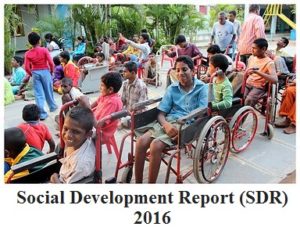According to the Social Development Report (SDR) 2016, in India, 45 percent of Persons with Disability (PWD) are illiterate.The theme of the report for 2016 is ‘Disabilities Rights Perspectives’
Highlights of the report
The report revealed that 38 percent of PWD males were illiterate while 55 percent of female PWD.Even in Kerala, which is known as a state associated with complete literacy, 33.1 percent of PWDs were illiterate.
- India’s overall literacy rate is 74 percent.The report also found for that in each category of disability, maximum illiteracy was among women as compared to men while the highest illiteracy rate of 76 per cent was among women with multiple disabilities
- The report also estimated that out of total 75 million children of primary school age who do not go to school, one-third are children with disabilities.

- The report directed the State governments to ensure availability of minimum support such as accommodation, assistive devices and transport for the disabled children to complete their schooling.
- The report was based on the data collected from various sources, including the census, the National Sample Survey (NSS), data-sets of the India Human Development Survey, and the National Family Health Survey, besides the new data from fresh empirical studies.
- The report considered that number of PWDs in India was 26.8 million, or 2.2 per cent of the population based on which Men formed 56 per cent of the PWDs while 70 per cent of the disabled population was rural.
- Among the disabilities, the largest numbers of PWDs were affected by Movement disability, followed by hearing disability and visual impairment.
- The report also revealed that the high level of polio occurance rate in India may be responsible for the high percentage of movement disability.The report also showed that 20 percent children accounted for movement disability.
- Mental illness and mental retardation constituted the lowest proportion among the PWDs, which may be a result of under-reporting because of the disapproving nature of psycho-social disabilities and poor diagnoses of medical conditions.
- In India, Sikkim, Odisha, Jammu and Kashmir and Lakshadweep had the highest incidence of disability, while Tamil Nadu, Assam and Delhi had the lowest proportions of the PWDs.
- According to the SDR, 64 per cent of the PWDs in India were non-workers while the majority were only able to find employment as casual labourer or agricultural labourer.
- Tamil Nadu had the least record in low employment rate, with 59 per cent of the PWDs being non-workers.
- The report also found that at the national level, only 2 per cent of the PWDs were enrolled in any vocational course, with the highest rate of enrolment being in Kerala, where 5 per cent were enrolled in vocational courses.
- Kerala performed the worst in giving employment to the PWDs, with a non-worker rate of 74.52 per cent, worst than national average.The report concluded that in the area of healthcare, the cost, lack of social services and transport were the top obstacles for the PWDs to access health care facilities.
AffairsCloud Recommends Oliveboard Mock Test
AffairsCloud Ebook - Support Us to Grow
Govt Jobs by Category
Bank Jobs Notification


